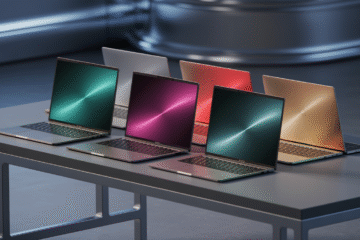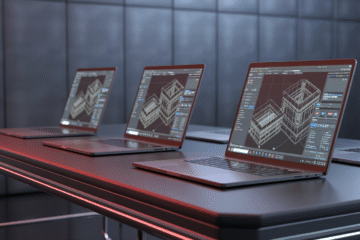6 Best Laptops for Video Editing in 2025: A No-Nonsense Buyer’s Guide
Picking a laptop for video editing isn’t just about headline specs. Smooth edits come from a well-balanced machine: a fast CPU for decoding/encoding, a capable GPU for timeline acceleration and effects, fast NVMe storage for big media, ample RAM for caches, and a color-reliable display so your grades look right on client screens. In this guide, we rank six editor-friendly laptops—from budget-savvy to pro-studio—so you can choose confidently based on workload, software, and budget.
How to Choose a Video Editing Laptop (What Actually Matters)
CPU & GPU: The Engine Behind Your Timeline
-
CPU (processor): Impacts playback smoothness, background renders, and export times. Modern multi-core chips handle H.264/H.265/HEVC/AV1 better thanks to built-in media engines.
-
GPU (graphics): Critical for accelerated effects, color, stabilization, noise reduction, and AI features in Premiere Pro, DaVinci Resolve, and Final Cut Pro. Aim for a dedicated GPU or powerful integrated graphics in the latest architectures.
RAM: Don’t Starve Your Cache
-
Minimum 16GB for 1080p timelines with light effects.
-
32GB is the sweet spot for 4K multicam, heavy grades, and motion graphics.
-
64GB+ if you routinely stack effects, use Fusion/After Effects, or cut long-form 4K/RAW.
Storage: NVMe or Nothing
-
1TB NVMe SSD recommended (OS, apps, scratch, proxies).
-
Keep external USB-C/Thunderbolt NVMe for media libraries and fast offloads. SATA HDDs belong to archived footage, not active projects.
Display: See the Grade You’re Making
-
Prefer 15″–16″ or larger, IPS or OLED, 300+ nits, 100% sRGB (ideally DCI-P3 coverage).
-
Matte/anti-glare helps in bright rooms. For critical color, use a calibrated external monitor.
Ports & Connectivity: Real-World Convenience
-
Thunderbolt/USB-C with DisplayPort/PD charging, full-size HDMI, and fast UHS-II SD card reader are practical time-savers.
-
Wi-Fi 6/6E for big cloud transfers and remote review links.
The Ranked List: 6 Laptops that Make Editing Easier
6- Nimo N151 IPS FHD Laptop — Entry-Level Editor That Punches Above Its Price
Who it’s for: Beginners moving from phone/desktop editing to a first laptop, YouTube shorts creators, and students learning Premiere Pro or Resolve with 1080p timelines.
Why it’s here: The Nimo N151 focuses on essentials—IPS FHD panel for decent color and viewing angles, upgradable storage in many configurations, and enough CPU/GPU power (depending on SKU) to handle 1080p edits, light color work, and basic motion graphics.
Editing experience:
-
1080p timelines: Smooth with proxies or optimized media when footage is highly compressed (H.265).
-
4K: Feasible with proxies and light effects; expect longer exports.
-
Thermals: Keep vents clear and consider a slim laptop stand during sustained renders.
Recommended config targets: 6+ CPU cores, 16GB RAM, 512GB–1TB NVMe, IPS FHD.
Pros: Budget-friendly, IPS screen, simple upgrade path.
Cons: Not ideal for heavy multicam 4K or intensive noise reduction/denoising; relies on proxies to stay snappy.
5- Auusda T152A Laptop — Value Choice with Room to Grow
Who it’s for: Editors stepping beyond basic 1080p—wedding highlights, vlogs, course videos, and simple commercial work—who still want strong value.
Why it’s here: The Auusda T152A typically ships with newer-gen CPUs and reasonable thermals for the class. Pair it with 32GB RAM and a 1TB NVMe and you get a credible 4K editing starter without overspending.
Editing experience:
-
Premiere/Resolve: GPU-accelerated effects feel responsive if you keep the effects stack sensible.
-
Audio workflows: Enough headroom to keep detailed tracks (dialogue, music stems, SFX) without stutters.
-
Color work: IPS helps; for client-critical color, connect a calibrated external monitor.
Recommended config targets: Recent multi-core CPU, mid-tier dGPU or strong iGPU, 32GB RAM, 1TB NVMe, 15–16″ IPS.
Pros: Great price-to-performance when specced right; versatile for YouTube and client pieces.
Cons: Displays vary by SKU—check brightness and gamut; may throttle under marathon renders.
4- HP 17 FHD Laptop — Big Screen, Easier Timelines
Who it’s for: Editors who want a large canvas (17″) for timelines, scopes, full-size bin views, and still prefer a single portable machine over a desktop plus monitor.
Why it’s here: The 17″ FHD form factor dramatically improves usability—fewer cramped panels, more room for scopes and inspector panes, and comfortable multicam oversight. HP’s build approach in this segment favors practical ports and serviceability.
Editing experience:
-
Timeline visibility: Extra vertical space simplifies trimming, keyframing, and color panel layouts.
-
Thermals: The larger chassis usually helps sustain clocks during long renders.
-
On-set: The big screen is helpful for rough cuts and quick client previews.
Recommended config targets: 8-core CPU, mid-range dGPU (or robust iGPU), 32GB RAM, 1TB NVMe, 17″ IPS FHD (or higher if available).
Pros: Spacious screen, comfortable thermals, dock-free I/O in many configs.
Cons: Heavier; battery life dips during sustained export; color accuracy can be average—pair with an external for grading.
3- Lenovo ThinkPad E16 Gen 1 — Business-Tough with Editor Brains
Who it’s for: Freelancers and production teams who value reliability, keyboard quality, and IT-friendly design—and who need a machine that travels well between shoots, offices, and client sites.
Why it’s here: ThinkPads are loved for consistent keyboards, trackpads, and serviceability. The E16 brings a 16:10 workspace that’s great for timelines and bins, with a sensible mix of ports for card readers, monitors, and fast storage.
Editing experience:
-
Ergonomics: Comfortable typing for long edit notes and scene logs.
-
Performance: With the right CPU/GPU and 32GB RAM, it handles 4K projects, LUTs, and moderate Fusion/AE work.
-
Color: IPS panels are workable, but critical grading still benefits from an external calibrated display.
Recommended config targets: Modern 8-core CPU, 32GB RAM, 1TB NVMe, 16:10 IPS 300+ nits, Wi-Fi 6/6E.
Pros: Great keyboard, durable build, pragmatic ports, business-class reliability.
Cons: Not a workstation monster; choose dGPU configs if Resolve/Fusion is central to your workflow.
2- Dell Inspiron Touchscreen Laptop — Touch-Friendly Power for Editors and Creators
Who it’s for: Editors who love touch input for scrub, trim, and storyboard work; creators juggling video, light design, and client presentations—often on the same machine.
Why it’s here: Recent Inspiron touch models pair modern CPUs with capable GPUs, high-speed NVMe, and color-friendly panels in 15–16″ sizes. Touch helps with quick timeline nudges, masking, and storyboard markup—especially in pre-production or client reviews.
Editing experience:
-
Premiere/Resolve: Timeline performance is solid in mid-to-upper configs; GPU acceleration keeps color and effects responsive.
-
Touch advantage: Handy for trimming, scrubbing, and reviewing—less so for pixel-perfect grading, but great for speed.
-
Audio & motion: Enough horsepower for layered audio and basic After Effects/Fusion comps.
Recommended config targets: High-efficiency multi-core CPU, mid-range dGPU, 32GB RAM, 1TB NVMe, 15–16″ touch IPS/OLED with good brightness.
Pros: Touch convenience, strong overall balance, good creator display options.
Cons: Touch layers add weight and can reduce battery life; manage brightness during long edits.
1- Apple MacBook Pro Laptop — The Mobile Editing Benchmark
Who it’s for: Editors who want top-tier timeline smoothness, excellent battery endurance under real workloads, class-leading media engines, and color-accurate displays out of the box—particularly strong for Final Cut Pro and DaVinci Resolve, with solid Premiere performance as well.
Why it’s number one: Current Apple Silicon MacBook Pro models combine efficient CPUs/GPUs with dedicated media engines that chew through H.264/H.265/HEVC and increasingly AV1. The Liquid Retina XDR displays (on supported models) are bright, wide-gamut, and consistent—excellent for on-the-go grading. Battery life under active editing is among the best you can get in a mobile system.
Editing experience:
-
4K timelines: Effortless playback with effects and grades; background renders feel invisible.
-
Multicam: Stays smooth when you use optimized/proxy media.
-
Audio & motion: Handles complex audio buses and motion graphics; export times are competitive, often class-leading for long H.264/H.265 jobs thanks to the media engine.
Recommended config targets: Recent Apple Silicon with multiple GPU cores, 32GB unified memory for 4K/FX-heavy edits (16GB for lighter work), 1TB–2TB internal SSD, 14″ or 16″ display.
Pros: Superb screen, standout battery, quiet thermals, best-in-class media engine.
Cons: Higher cost; fewer native ports than some PC rivals (though newer models restored HDMI/SD), and certain niche plugins may arrive later on macOS.
Which One Should You Buy?
-
Tight budget, learning the craft: Nimo N151 IPS FHD – Perfect as your first editing laptop if you commit to proxies and keep effects sensible.
-
Best value step-up for 4K: Auusda T152A – Configure it right (32GB/1TB) and it handles serious YouTube/commercial work.
-
Big screen comfort: HP 17 FHD – A 17″ canvas changes everything for timelines and scopes; add a calibrated external for color.
-
Business-ready reliability: ThinkPad E16 Gen 1 – Great keyboard, solid build, and enough muscle for real 4K projects with the right dGPU.
-
Touch convenience for creators: Dell Inspiron Touchscreen – Touch speeds up trims/review; strong all-round editor when specced well.
-
Best overall for professionals: MacBook Pro – Top choice for editors who want speed, color, and battery without fuss.
Pro Tips to Make Any Editing Laptop Feel Faster
1) Master Proxies and Optimized Media
Transcode long-GOP footage (H.264/H.265/HEVC) to ProRes or DNxHR proxies. Your timeline will feel instantly smoother, even on modest hardware.
2) Split Your Storage Like a Pro
-
Internal SSD: OS, apps, caches, and proxies.
-
External NVMe (USB-C/Thunderbolt): Active project media and exports.
-
Archive drive/NAS: Finished projects and backups.
3) Keep the OS Lean
Disable bloat, background updaters, and heavy startup apps. In the NLE, purge media cache regularly and cap playback resolution to match your needs.
4) Calibrate for Confidence
If the built-in display isn’t reference-grade, use a hardware calibrator or edit on a calibrated external monitor. Clients pay for consistency.
5) Cool, Quiet, and Consistent
Use a slim cooling stand, keep vents clean, and avoid editing in sunlit, hot environments. Thermal throttling kills export times.
Frequently Asked Questions
Is 16GB RAM enough for 4K?
It can be—with proxies and light effects. For real-time color, multicam, and heavier motion graphics, 32GB is a safer baseline.
Do I need a dedicated GPU?
For Premiere Pro and DaVinci Resolve, a dGPU (or a very strong integrated solution with modern media engines) significantly improves playback and effects. Final Cut is highly optimized and can do more with less GPU, but still benefits from more GPU cores.
FHD vs 4K laptop display?
FHD IPS can be fine with an external calibrated monitor. A higher-res or wide-gamut panel is nicer for mobile color accuracy, but don’t sacrifice CPU/GPU/RAM for pixels alone.
Internal 512GB vs 1TB?
Go 1TB if you can; media caches and proxies eat space. Pair with a fast external NVMe for projects.
Final Take
For sheer mobile editing polish without headaches, the Apple MacBook Pro sits at the top—fast timelines, stellar screen, outstanding battery, and best-in-class media engines. If you prefer Windows, the Dell Inspiron Touchscreen offers creator-friendly power with touch convenience, while the Lenovo ThinkPad E16 Gen 1 delivers a dependable, business-class editing experience. Editors who crave screen real estate will love the HP 17 FHD, and value hunters should look hard at the Auusda T152A—just spec it to 32GB/1TB. On a strict budget, the Nimo N151 IPS FHD is a smart starting point, especially if you embrace proxies.
Choose the model that matches your workload, invest in RAM and fast NVMe storage, and keep your media pipeline organized. Do that, and you’ll spend less time waiting—and more time delivering edits that look exactly the way you intended.



0 Comments